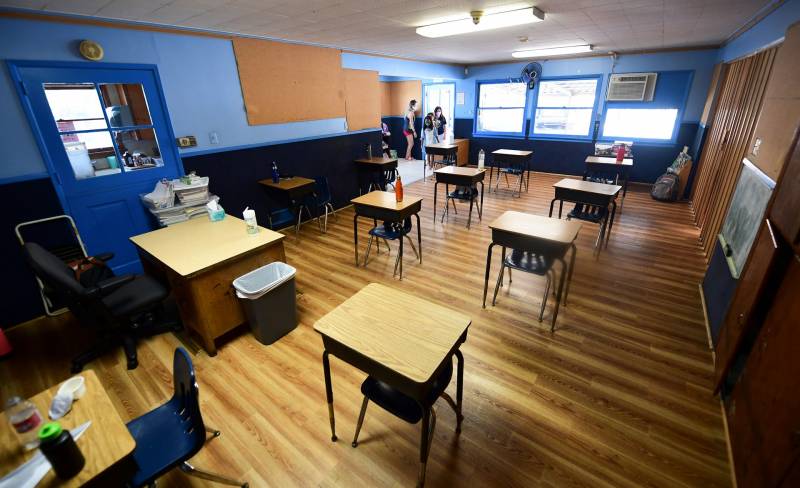“If you are not on that monitoring list you can move forward as a county if you choose to physically open your campus, physically open your schools,” Newsom said at a noon press briefing. “However schools that don’t meet this requirement — they must begin the school year this fall through distance learning.”
The strict new regulations marked a dramatic shift from Newsom’s earlier position that it was up to local school districts and boards to decide when and how to reopen. The announcement, which follows his sweeping rollback Monday of plans to reopen businesses, comes just weeks before many of the state’s more than 1,000 school districts are set to resume instruction in mid-to-late August.
As school districts wrestle with the decision, teachers unions, parents and school officials have urged state leaders to provide more direction on whether it is safe to go back to school.
California this week reported its second-highest one-day totals in new infections and deaths since the start of the pandemic, with an average of 8,838 positive cases a day over the last week and a 22% increase in hospitalizations in the past 14 days. More than 7,500 people in California have died from COVID-19 since the start of the pandemic, including over 1,100 in just the last two weeks.
A father of four young children, Newsom acknowledged the difficulty this situation will create for scores of schools, students and working parents.
“Our students, our teachers, staff and certainly parents, we all prefer in-classroom instruction for all the obvious reasons, but only if it can be done safely,” Newsom said, noting the more than 6 million students and 625,000 teachers and other staff members in California’s public schools. “But safety is foundational and safety will ultimately make the determination of how we go about educating our kids as we move into the fall.”
The updated guidance from the state Department of Public Health lays out in detail the rules that both public and private schools throughout the state must follow when they reopen. It requires all school staff and all students in third through 12th grades to wear face coverings. Younger students are also encouraged to wear them.
All adults in schools will also be required to stay six feet away from one another and six feet away from children, while students should be encouraged to maintain that same distance from each other whenever possible.
Anyone entering a school must be temperature checked, and any teachers or students with a fever or other symptoms have to be sent home immediately. Staff members must also be tested for the virus on a rotating basis, with school sites required to make ample hand-washing stations available and implement other ”deep sanitation, deep disinfection” measures Newsom said.
The state guidance also spells out when classrooms and schools would be required to close if there is a local outbreak. If a student or educator tests positive for the virus, all students and staff exposed to that person should be quarantined for 14 days.
Meanwhile, an entire school would have to revert to distance learning if multiple cases are reported, or if 5% percent of students and staff test positive within a 14-day period. And an entire district would have to revert to distance learning if 25% or more of its schools have been physically closed due to COVID-19 within a 14-day period.
“The one thing we have the power to do to get our kids back into school? Wear a mask, physically distance, wash your hands," Newsom said.
Newsom emphasized that schools “must provide meaningful instruction during the pandemic, whether they are physically opened or not.” He called for “rigorous online and distance learning,” while also noting the formidable challenges many schools faced in the spring, particularly in regard to technology resources and internet connectivity issues.
“Access to devices is one thing, and connectivity, it's foundational,” Newsom said, pointing to funds still available from a $5.3 billion package passed last spring that districts could access to "address this yawning gap as it relates to the digital divide."
“We want daily live interaction with teachers and other students, students connecting peer-to-peer with other students, teachers connecting daily and an interactive frame to advance our distance learning efforts,” Newsom said. Schools, he added, must also make specific remote learning accommodations for students with special needs, including homeless and foster care students, those with learning disabilities and English language learners.
“I think we’re going to see a lot more capacity this school year than we were able to have in all districts last school year, to really respond to both classrooms as a whole and the needs of particular students,” State Board of Education President Linda Darling-Hammond said.
Newsom’s administration and the state Department of Education had released guidelines in early June for districts to follow when reopening, including implementing temperature checks for students, remaking activities such as lunch and recess and recommending cloth face coverings for students and teachers. But at that time, California had managed to keep its COVID-19 case count under control.
“Since we’ve issued our guidance, conditions have changed dramatically,” State Superintendent of Public Instruction Tony Thurmond said during a media briefing Wednesday.
Republican Assemblyman Kevin Kiley from Sacramento accused the governor of listening to “special interests, not science" in laying out the rules.
“Rather than adopting a balanced approach that provides California families options for classroom-based and home-based learning, the governor is shutting down the vast majority of schools across the state," Kiley said.

